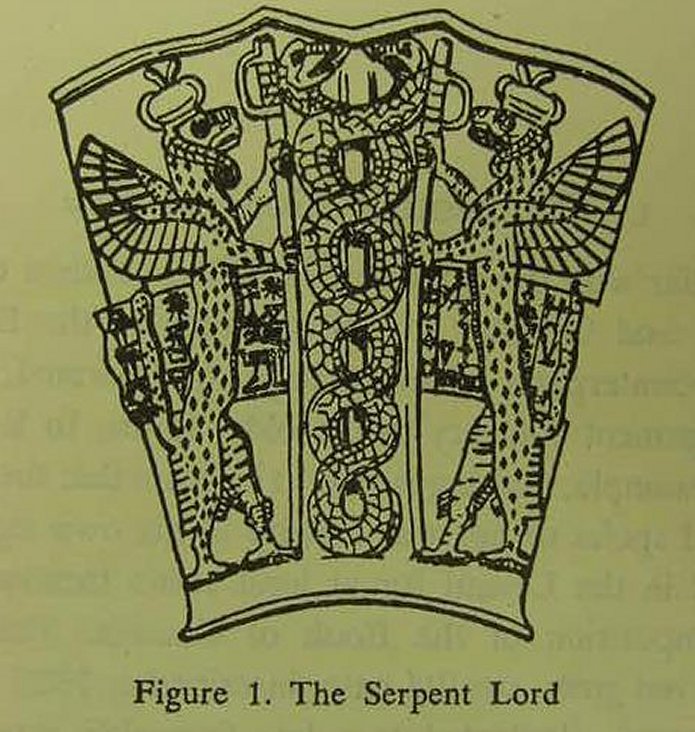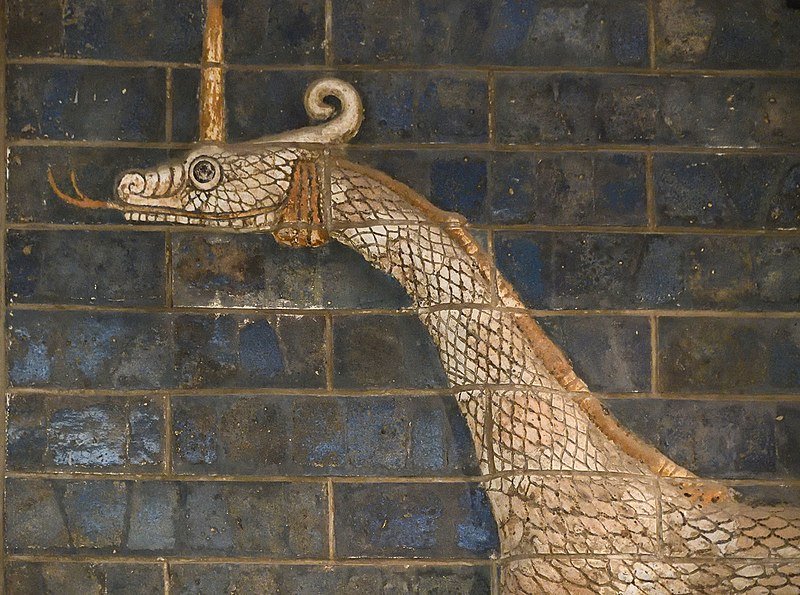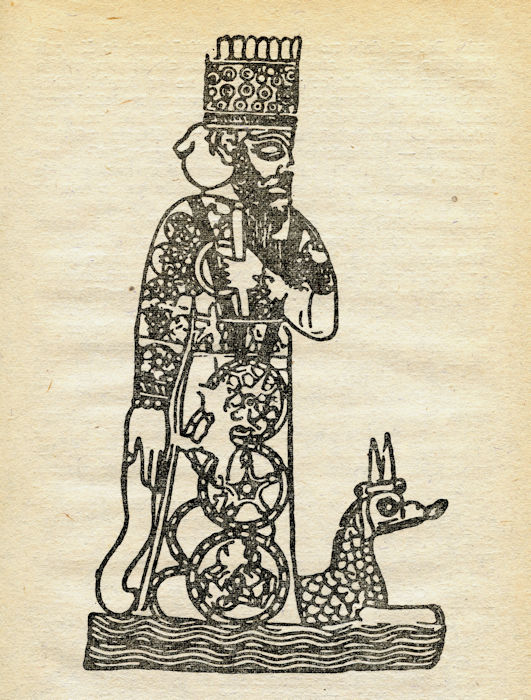A. Sutherland – AncientPages.com – Sirrush (Mushrush, Mushrushu) is a hybrid creature depicted on the Ishtar gate in Babylon. It resembles a dragon or a griffin, and it is the most famous image of this creature, displayed on the walls and gates of the procession path in Babylon.

Ningizzida in the middle, followed by the dragon Mushussu. Stone vase work “libation vase of Gudea”. Image source – Public Domain
Sirrush has a horned snakehead, a scaly snake body, a long neck, a long tail, and scales. The slim scaly neck has the head of a serpent with a horn and a long forked tongue.
Because the tiles show a side view, only one horn can be seen, but two horns are clearly shown in other depictions. Flaps of skin cover the ears.
The creature’s feet were remarkable and somewhat unusual. The forefeet being those of a feline, perhaps a leopard or a panther. On the other hand, the hind feet were large and birdlike, with four toes covered with scales.
This animal is identical to the dragons guarding Marduk and is considered one of his symbols.
The name ‘sirrush’ originates from the Akkadian word, roughly translated as a ‘magnificent serpent.’ The early researchers probably misread the тιтle, and since then, “sirrush” has been used as the most common name for this creature. Other variations of its name include Mushussu (“the furious snake”), Musrussu dragon, and Sirrušu.

Mušḫuššu dragon in Istanbul Ancient Orient Museum Ishtar Gate. Image credit: Dosseman – CC BY-SA 4.0
The German archaeologist Robert Koldewey, who found the Ishtar Gate during his excavations from 1899 until 1917, was convinced that the ‘Sirrush’ existed.
He argued that in terms of the uniformity of his physiological concept, ‘Sirrush’ significantly surpᴀsses all other legendary creatures.
The fact that ‘Sirrushi’ was depicted next to real animals (for example, lions), according to Koldewey, proved that the Babylonians were familiar with this creature, mentioned in ancient Mesopotamian mythology. One theory suggested that the Babylonians could copy the appearance of the Sirrush from the remains of prehistoric lizards, mainly because the animal resembles the so-called monitor lizards, which could be known to the Babylonians.
According to theories, the Sirrush’s appearance was based on ancient stories about an animal that did not live in Mesopotamia.
According to written sources, the Sirrush was initially an animal of Ninazu, the god of Eshnunna (an ancient Sumerian and later Akkadian city and city-state in central Mesopotamia).

Marduk and his dragon Sirrush. Credit: Adobe Stock – Juulijs
In the Akkadian or early Babylonian times (18th century BC), this fantastic mythological hybrid animal was related to the god Tishpak, who replaced the guardian god of the city with this creature. In Lagash, on the other hand, he began to be ᴀssociated with the son of Ninazu, the god Ningishida.
One of the most significant Babylonian-ᴀssyrian gods, Nabu, was said to be the keeper of the tablet of fate regarding the ancient Babylonians and ᴀssyrians.
He used to ride on a winged dragon known as Sirrush that initially belonged to his father, Marduk.
The Sirrush was referred to in Babylonian cuneiform inscriptions as Musrussu, meaning “Glamorous Snake” or “Splendor Serpent.” The creature was identified with the mythical serpent-dragon mushkhushshu (or mushushu). This identification was significantly possible thanks to the texts from the inscriptions of King Nebuchadnezzar II.
These texts were devoted to construction work in Babylon conducted by this great ruler of ancient Babylonia and conquerer of Judah. With time, the Sirrush was transferred to ᴀssyria and ᴀssociated with the local state god Ashur, an equivalent of Enlil.
Written by – A. Sutherland – AncientPages.com Senior Staff Writer
Updated on February 6, 2023
Copyright © AncientPages.com All rights reserved. This material may not be published, broadcast, rewritten or redistributed in whole or part without the express written permission of AncientPages.com
Expand for references
References:
Kriwaczek P., Babylon: Mesopotamia and the Birth of Civilization
Enthralling History, Ancient Mesopotamia





